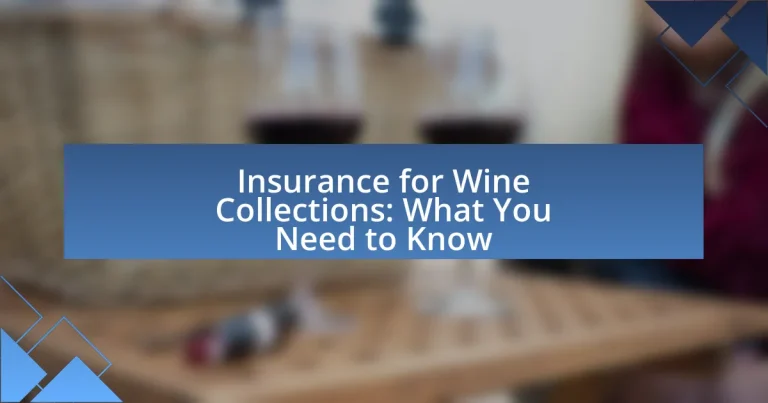Insurance for wine collections is a specialized coverage designed to protect valuable wine investments from risks such as theft, damage, and loss. This article outlines the importance of insuring wine collections, the various risks faced without insurance, and the types of insurance available, including specialized wine insurance and homeowners insurance riders. It also discusses how to determine the value of a wine collection for insurance purposes, common exclusions in policies, and best practices for maintaining adequate coverage. Additionally, the article provides guidance on filing claims and selecting the right insurance provider to ensure comprehensive protection for wine collectors.

What is Insurance for Wine Collections?
Insurance for wine collections is a specialized type of coverage designed to protect the financial investment in wine against risks such as theft, damage, or loss. This insurance typically covers the full value of the collection, which can be significant, as fine wines can appreciate over time and may be valued in the thousands or even millions of dollars. Policies often include provisions for climate control, as proper storage conditions are crucial for maintaining wine quality, and may also cover transportation and storage in third-party facilities.
Why is it important to insure a wine collection?
Insuring a wine collection is important to protect against financial loss due to theft, damage, or unforeseen events. Wine collections can be highly valuable, with some bottles worth thousands of dollars; therefore, insurance provides a safety net that ensures collectors can recover their investment. According to the Insurance Information Institute, specialized wine insurance can cover various risks, including natural disasters and accidental breakage, which are not typically included in standard homeowners’ policies. This tailored coverage is essential for safeguarding the unique and often irreplaceable nature of fine wines.
What risks does a wine collection face without insurance?
A wine collection without insurance faces significant risks including theft, damage, and loss due to unforeseen events. Theft can result in the complete loss of valuable bottles, while damage from environmental factors such as temperature fluctuations or natural disasters can ruin the quality of the wine. Additionally, accidental breakage or spillage can lead to financial loss. According to a report by the Insurance Information Institute, personal property, including collectibles like wine, is often underinsured, leaving collectors vulnerable to substantial financial setbacks in the event of a loss.
How can insurance protect against these risks?
Insurance can protect against risks to wine collections by providing financial compensation for losses due to theft, damage, or natural disasters. For instance, specialized wine insurance policies cover perils such as fire, flood, and accidental breakage, ensuring that collectors can recover the value of their investments. According to the Insurance Information Institute, homeowners insurance typically does not cover valuable collections, making dedicated wine insurance essential for safeguarding against potential financial loss.
What types of insurance are available for wine collections?
There are several types of insurance available for wine collections, including specialized wine insurance, homeowners insurance with a rider for collectibles, and personal property insurance. Specialized wine insurance is designed specifically to cover the unique risks associated with wine collections, such as temperature fluctuations, theft, and damage. Homeowners insurance can sometimes be adjusted with a rider to include coverage for valuable items like wine, but this may have limitations. Personal property insurance can also cover wine collections, but it typically requires a detailed inventory and may not cover all risks. These options provide varying levels of protection tailored to the specific needs of wine collectors.
What is the difference between standard homeowners insurance and specialized wine insurance?
Standard homeowners insurance typically covers personal property, including furniture and appliances, but may not adequately protect valuable wine collections against specific risks such as temperature fluctuations, theft, or damage during transport. Specialized wine insurance, on the other hand, is designed specifically for wine collections, offering coverage for loss, damage, and liability related to wine storage and transportation, often including provisions for climate control and unique risks associated with fine wines. This distinction is crucial for collectors, as standard policies may limit coverage amounts or exclude certain types of damage, while specialized wine insurance provides tailored protection to safeguard valuable assets.
What coverage options are typically included in wine insurance policies?
Wine insurance policies typically include coverage options such as loss or damage due to theft, fire, and natural disasters. These policies often extend to cover spoilage from temperature fluctuations, accidental breakage, and even loss during transit. Additionally, many wine insurance policies provide coverage for the full value of the collection, ensuring that collectors are compensated for the current market value of their wines. This comprehensive coverage is essential for protecting valuable wine collections, which can appreciate significantly over time.
How do you determine the value of a wine collection for insurance purposes?
To determine the value of a wine collection for insurance purposes, conduct a thorough appraisal that considers the current market value of each bottle, the collection’s provenance, and its condition. Professional appraisers often utilize resources such as wine price databases, auction results, and market trends to establish accurate valuations. For instance, the Wine Market Journal provides historical pricing data that can help assess the value of specific vintages and brands, ensuring that the valuation reflects the true worth of the collection in the current market.
What factors should be considered when appraising a wine collection?
When appraising a wine collection, several key factors must be considered, including provenance, condition, market demand, and rarity. Provenance refers to the history of ownership and storage conditions, which significantly impacts a wine’s value; for example, wines stored in optimal conditions are generally more valuable. The condition of the bottles, including fill level, label integrity, and cork quality, also affects appraisal, as wines in pristine condition command higher prices. Market demand is crucial, as certain vintages or regions may be more sought after, influencing their market value. Lastly, rarity plays a significant role; limited production wines or those from exceptional vintages tend to appreciate more over time, making them more valuable in an appraisal context.
How often should a wine collection be re-evaluated for insurance coverage?
A wine collection should be re-evaluated for insurance coverage every three to five years. This timeframe allows for adjustments based on market fluctuations, changes in the collection’s value, and any additions or losses to the collection. Regular re-evaluation ensures that the insurance coverage accurately reflects the current worth of the collection, which can significantly change due to factors such as vintage quality and market demand.
What are the common exclusions in wine insurance policies?
Common exclusions in wine insurance policies typically include damage due to natural disasters, such as floods or earthquakes, as well as losses resulting from improper storage conditions, like temperature fluctuations or humidity issues. Additionally, many policies exclude coverage for theft if the wine was not stored in a secured location or if the theft was due to negligence. Other exclusions may involve damage from pests or vermin, as well as losses related to market fluctuations in wine value. These exclusions are standard across many insurance providers to mitigate risk and ensure that coverage is focused on specific, insurable events.
What types of damage or loss are typically not covered?
Types of damage or loss typically not covered in wine collection insurance include damage from natural disasters, such as floods or earthquakes, and losses due to improper storage conditions, like temperature fluctuations. Additionally, theft or loss resulting from negligence, such as leaving a wine cellar unlocked, is often excluded. These exclusions are standard in many insurance policies, as they aim to mitigate risks that are deemed preventable or outside the insurer’s control.
How can collectors mitigate risks associated with these exclusions?
Collectors can mitigate risks associated with exclusions in wine insurance by thoroughly understanding their policy terms and seeking additional coverage options. By reviewing the specific exclusions listed in their insurance policy, collectors can identify potential gaps in coverage and address them proactively. For instance, if a policy excludes certain types of damage, collectors can purchase additional riders or endorsements that specifically cover those risks. Furthermore, maintaining detailed records of their wine collection, including provenance and condition, can help in claims processes and ensure that all items are adequately insured. According to a study by the Insurance Information Institute, understanding policy details and maintaining accurate inventory can significantly reduce the likelihood of disputes during claims, thereby enhancing overall protection for collectors.
How can you file a claim on your wine insurance?
To file a claim on your wine insurance, contact your insurance provider directly and provide them with the necessary documentation, including proof of ownership and details of the incident. Most wine insurance policies require you to notify them within a specific timeframe after the loss occurs, typically within 30 days. Additionally, you may need to fill out a claim form and submit any relevant photographs or appraisals to support your claim. Following these steps ensures that your claim is processed efficiently and accurately.
What steps should be taken immediately after a loss occurs?
Immediately after a loss occurs, the first step is to document the loss thoroughly, including taking photographs and making a detailed inventory of the damaged or lost items. This documentation is crucial for filing an insurance claim effectively. Next, notify your insurance provider as soon as possible to initiate the claims process, as many policies have specific timeframes for reporting losses. Additionally, secure the remaining property to prevent further damage, and keep all receipts related to the loss for potential reimbursement. These steps are essential to ensure a smooth claims process and to maximize the recovery from your insurance policy.
What documentation is typically required to support a claim?
To support a claim for insurance on wine collections, typically required documentation includes a detailed inventory of the wine collection, purchase receipts or invoices, photographs of the bottles and storage conditions, and any appraisals or valuations conducted by a certified expert. This documentation substantiates the existence, value, and condition of the wine collection, which is essential for processing claims effectively.
What are the best practices for maintaining insurance on a wine collection?
The best practices for maintaining insurance on a wine collection include regularly updating the inventory, ensuring proper valuation, and reviewing policy coverage. Regularly updating the inventory allows for accurate documentation of the collection’s current value and condition, which is essential for claims. Proper valuation should be based on market trends and expert appraisals to reflect the true worth of the collection. Additionally, reviewing policy coverage ensures that the insurance adequately protects against risks such as theft, damage, or loss, which are common concerns for wine collectors. These practices help mitigate potential financial losses and ensure comprehensive protection for the wine collection.
How can collectors ensure their insurance remains adequate over time?
Collectors can ensure their insurance remains adequate over time by regularly reassessing the value of their collections and updating their policies accordingly. This involves conducting periodic appraisals, ideally every few years, to reflect changes in market value and condition. For instance, wine values can fluctuate significantly due to factors such as vintage quality and market demand, necessitating adjustments in coverage. Additionally, maintaining detailed records of acquisitions, sales, and appraisals provides a solid basis for discussions with insurance providers, ensuring that coverage aligns with the current value of the collection.
What tips can help in selecting the right insurance provider for wine collections?
To select the right insurance provider for wine collections, prioritize companies that specialize in fine wine insurance and have a proven track record in this niche. Look for providers that offer coverage tailored specifically for wine collections, including protection against theft, damage, and loss due to environmental factors. Verify the insurer’s financial stability and customer reviews to ensure reliability; for instance, companies like Chubb and Hiscox are known for their expertise in insuring high-value items, including wine. Additionally, assess the policy details, such as coverage limits, deductibles, and any exclusions, to ensure comprehensive protection for your collection.


